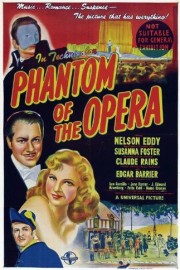Phantom of the Opera
This is now the third cinematic version of this story I’ve seen, and the conclusion I’ve arrived at is unmistakable- I’m just not that thrilled with the story. Each film- the Lon Cheney silent film, this Universal production, and Joel Schumacher’s adaptation of the musical- has positive aspects to its telling, but none of them really pull me in the way a good horror tale goes. Multiple versions of the Dracula story draw me in, and Frankenstein and the Mummy have had compelling runs, but it’s amazing that this tale of terror from Gaston Leroux, with an emphasis on music, is simply good, but not great. None of the three films are bad, but none of them really make me want to revisit them. Maybe it’s because of the inherent theatricality of the story itself.
When Universal made “Phantom” a part of their movie monsters legacy in 1943, it’s perhaps not surprising that the film, directed by Arthur Lubin, would be in color. By that point, color had been introduced by “Gone With the Wind,” “The Wizard of Oz” and others, and with the setting being a Paris opera house, the Technicolor process could make the film distinguished from the 1925 silent version, which relied on Gothic set design and a truly grotesque makeup job on Cheney as a musician/composer who looks out for a rising star named Christine with whom he is infatuated. The catacombs beneath the opera house are wonderful production design, but are more elegant than terrifying, as is the look of the Phantom himself, played here by Claude Rains. The identity of the Phantom is Erique Claudin, a musician in the orchestra at the opera house who has grown affectionate towards the lead singer’s understudy, Christine (Susanna Foster). He has been helping her from afar by paying for her singing lessons with a world-class teacher, as well as working on a concerto that will make him famous. He sees her talent and nurtures it, but after he is thrown out of the orchestra, his carefully laid plans for himself and Christine go to waste. When it appears his concerto is stolen, he attacks the binder he gave it to in a rage, and murders him while sustaining burns on his face from acid thrown at him from his victim’s wife. Wanted for murder, he now stalks the opera house, hoping to convince the people in charge to make Christine the star, or else terrible retribution will occur.
The performances by Rains and Foster make this telling of the story a successful one, of course they are the most compelling characters, as well. The original music is lush and wonderful and goes beautifully with the Technicolor images, but the central performances are what matter most. Rains was haunting and heartbreaking as “The Invisible Man,” and his Phantom is only slightly below that performance in stature, while Foster gives Christine a warmth and innocence that is necessary to make the part engaging. As a whole, the story is too thin, with nothing really surrounding the central drama, to rate with the great horror movies of the time, but Universal mounted a wonderful production for the story that helps transcend those limitations to a point.










